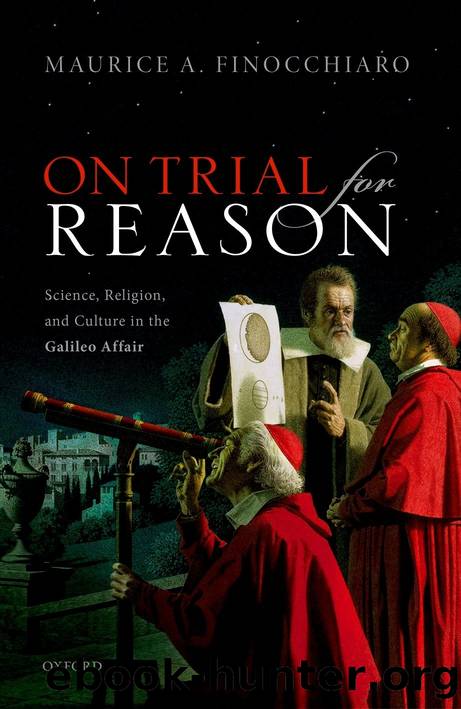On Trial for Reason by Finocchiaro Maurice A.;

Author:Finocchiaro, Maurice A.; [Finocchiaro, Maurice A.]
Language: eng
Format: epub
Publisher: Oxford University Press, Incorporated
Published: 2019-05-30T00:00:00+00:00
Now, consider how these two motions combine with each other. For a terrestrial point located on the opposite side from the Sun and experiencing midnight, for example D, the diurnal speed and the annual speed are in the same direction, toward the left; so they add up to give point D an actual speed that is the sum of the two, by reference to absolute space or at least to the center of the Sun A. But for a terrestrial point located on the side facing the Sun and experiencing noon, for example F, the annual and diurnal speeds are in opposite directions, the former still toward the left but the latter toward the right; thus they work against each other to give point F an actual speed that is the difference between the (greater) annual speed and the (smaller) diurnal speed. For intermediate midway points on the Earthâs surface, such as E and G, their diurnal speed has no effect on their annual speed, at least from the point of view of the west-to-east (i.e., right-to-left) direction; thus, such points move toward the left with a speed equal to just the annual speed.
At D the total actual speed is the maximum; at F it is the minimum. This applies to every point on the Earthâs surface in the course of 24 hours, and so any such point will alternate between such a maximum and a minimum speed. Moreover, in moving from D (through E) to F, a terrestrial point is undergoing retardation; whereas in moving from F (through G) to D, it is undergoing acceleration. This also applies to every point on the Earth, and so we may also say that every day every such point experiences acceleration for 12 hours and then retardation for another 12 hours, and so on. Furthermore, while moving from G to D and to E, every terrestrial point moves at a speed that is greater than the annual speed; whereas, when moving from E to F and to G, it moves at a speed that is smaller than the annual speed. So we may also say that every day every point on the Earth alternates between moving at a speed greater than the annual speed for 12 hours, and moving at a lower speed for the next 12 hours, and so on.
The daily accelerations and retardations just described constitute for Galileo the primary cause of the tidal motions of the sea. That is, he means partly that without such changes of speed there would be no tides; in this sense, they provide a necessary condition for the tides. He also means that such changes of speed get the whole process of the tides started; and in this sense, they contribute to the production of the tides. However, by itself the primary cause is not sufficient, and we need other concomitant causes, which he subdivides into secondary and tertiary causes. The secondary causes involve the fluid properties of water, which Galileo elaborates at length.
Download
This site does not store any files on its server. We only index and link to content provided by other sites. Please contact the content providers to delete copyright contents if any and email us, we'll remove relevant links or contents immediately.
A Brief Introduction to Classical Mechanics with Illustrative Problems (181 Pages) by Shahen Hacyan(257)
Physics in Minutes by Giles Sparrow(252)
Understandable Statistics. Concepts and Methods by Charles Henry Brase Corrinne Pellillo Brase Jason Dolor James Seibert(226)
Modern Physics by Gary N. Felder and Kenny M. Felder(226)
Calculus - Single and Multivariable 6th ed. by D. Hughes-Hallett(221)
Fundamentals of Physics I by R. Shankar;(217)
A History of Mathematical Impossibility by Lützen Jesper;(214)
Meat Less: The Next Food Revolution by David Julian McClements(206)
The synthesis, spectroscopic properties and X-ray structure of Zn(II) complexes with amino derivatives of chromone by Bogumiła Kupcewicz & Magdalena Grazul & Ingo-Peter Lorenz & Peter Mayer & Elzbieta Budzisz(200)
Probabilistic Risk Analysis and Bayesian Decision Theory by Marcel van Oijen & Mark Brewer(198)
Principles of Modern Chemistry by David W. Oxtoby H.P. Gillis & Laurie J. Butler(197)
Iraq at the Crossroads by Toby Dodge(195)
Practical Math Success in 20 Minutes a Day by Mark A. McKibben(185)
Sensory Ecology, Behaviour, and Evolution by Stevens Martin;(183)
A Mathematician Comes of Age by Krantz Steven G(182)
The Parrot in the Mirror by Antone Martinho-Truswell(181)
Chemistry for the IB Diploma Third edition by Christopher Talbot Chris Davison(168)
B. Everitt (ed.) Encyclopedia of Statistics in Behavioral Science by Volume-2(166)
Calculus, Early Transcendentals, International Metric Eighth Edition by James Stewart(166)
